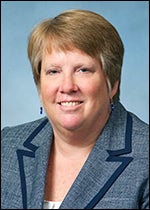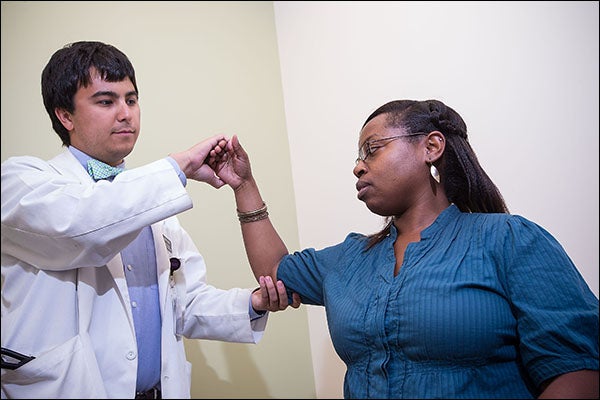ACCELERATING CHANGE
Brody School of Medicine receives $1 million national award
https://www.youtube.com/watch?v=jXlBGpD9AKU
East Carolina University’s Brody School of Medicine is one of 11 schools in the nation selected for a $1 million grant from the American Medical Association to change the way it educates students while keeping its focus on rural and underserved populations.

Dr. Elizabeth Baxley
The American Medical Association announced the winners June 14 at its annual meeting in Chicago. ECU will receive funding through the AMA’s $11 million Accelerating Change in Medical Education Initiative aimed at transforming the way future physicians are trained.
“This grant provides Brody and the ECU Division of Health Sciences with the opportunity to create and test new models of medical education. All students will benefit from the changes we are planning,” said Dr. Elizabeth Baxley, senior associate dean for academic affairs and professor of family medicine in the Brody School of Medicine. Dr. Luan Lawson, assistant dean of academic affairs and professor of emergency medicine, is co-principal investigator for the grant.
The university will implement a new comprehensive core curriculum in patient safety and clinical quality improvement for all medical students. It will feature integration with other health-related disciplines to foster interprofessional skills and prepare students to successfully lead health care teams as part of the transformation, Baxley said.
“Our medical schools today not only have the imperative to teach the art and science of medical care, but to train our graduates how to work in, and improve, complex health systems,” Baxley said. “Preparing students to work in teams with other health professionals is a hallmark of the needed changes, as is a better understanding of the ‘health’ of a community and how we can positively impact that.”
Additionally, up to 10 students each year will be selected to become LINC or Leaders in Innovative Care Scholars. These students will complete additional course work and lead projects to improve care. At the end of their training, they will earn a certificate in health care transformation and leadership.
The grant also will provide training for faculty members to teach the new program. Interested faculty will be recruited to a Teachers of Quality Academy, which will provide opportunities to learn more about patient safety, quality improvement and team-based care and explore new ways of teaching that engage students more actively in their own education, Baxley said.
Strategies will include e-learning, simulation, problem-based learning, clinical skills training and targeted clinical experiences. Emphasis on rural and underserved populations remains a fundamental part of Brody’s mission.
In addition to ECU, the following schools received funding: Indiana University School of Medicine; Mayo Medical School; NYU School of Medicine; Oregon Health & Science University School of Medicine; Penn State College of Medicine; The Warren Alpert Medical School of Brown University; University of California, Davis School of Medicine; University of California, San Francisco School of Medicine; University of Michigan Medical School; and Vanderbilt University School of Medicine.
“We are thrilled to award funding to 11 medical schools for their bold, transformative proposals designed to close the gaps between how medical students are trained and how health care is delivered,” said AMA President Dr. Jeremy A. Lazarus. “This AMA initiative will identify specific changes in medical education that can be applied in medical schools throughout the nation to enable students to thrive in a changing health care environment and improve the health of our nation’s patients.”
The proposals encompass many educational innovations, including models for competency-based student progression, total student immersion within the health care system from the first day of medical school and the increased use of health information technology and virtual patients.
The AMA will provide $1 million to each school over five years. A critical component of the AMA’s initiative will be to establish a learning consortium to disseminate rapidly best practices to other medical and health profession schools.
Of the 141 eligible medical schools, 119 – more than 80 percent – submitted letters of intent outlining their proposals in February. In March, 28 individual schools and three collaborative groups of schools were selected to submit full proposals before a national advisory panel worked with the AMA to select the final 11 schools.
For more information about the initiative, visit www.changemeded.org. To read short descriptions of each proposal, visit http://www.ama-assn.org/sub/accelerating-change/grant-projects.shtml.

Third year Brody School of Medicine student Jason Lomboy performs a medical check for Alicia Smallwood. (Photo by Cliff Hollis)